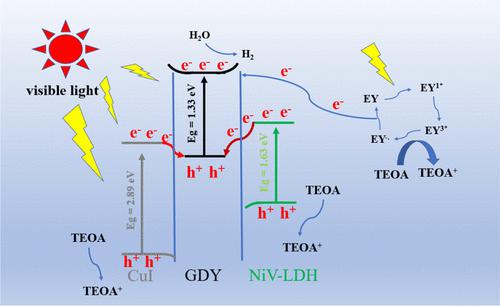当前位置:
X-MOL 学术
›
Energy Fuels
›
论文详情
Our official English website, www.x-mol.net, welcomes your
feedback! (Note: you will need to create a separate account there.)
In Situ X-ray Photoelectron Spectroscopy (XPS) Demonstrated Graphdiyne (g-CnH2n–2) Based GDY-CuI/NiV-LDH Double S-Scheme Heterojunction for Efficient Photocatalytic Hydrogen Evolution
Energy & Fuels ( IF 5.2 ) Pub Date : 2023-03-20 , DOI: 10.1021/acs.energyfuels.3c00011 Mei Li 1 , Jingzhi Wang 1 , Zhiliang Jin 1
Energy & Fuels ( IF 5.2 ) Pub Date : 2023-03-20 , DOI: 10.1021/acs.energyfuels.3c00011 Mei Li 1 , Jingzhi Wang 1 , Zhiliang Jin 1
Affiliation

|
As a new two-dimensional layered carbon material, graphdiyne (GDY) is widely used in various fields because of its excellent electrical conductivity and tunable electronic structure. In this work, graphdiyne, a two-dimensional layered carbon material, is prepared by an alkyl terminal coupling method using Cu+ as a catalyst. Nickel–vanadium hydro calcite (NiV-LDH) is anchored on the surface of GDY-CuI bya solvothermal method to form a double S-scheme heterojunction photocatalytic hydrogen precipitation system. The double S-scheme heterojunction suppressed the electron–hole recombination in the composite catalyst, which greatly improved the transfer rate of photogenerated carriers. Meanwhile, a tight and unique interface is formed in the composite, which not only accelerates the separation and transfer of electron holes but also improves the catalytic stability of the composite. H2 (73.65 μmol) is produced in 5 h in triethanolamine solution, which is 4.1 and 3.7 times higher than those with NiV-LDH and NiV-LDH/CuI. Twenty-five hour cycling experiments demonstrated the catalytic stability of the materials. This work provides an effective strategy for the rational construction and application of graphdiyne group hetero structures in the field of photocatalytic hydrogen evolution.
中文翻译:

原位 X 射线光电子能谱 (XPS) 证明基于石墨二炔 (g-CnH2n–2) 的 GDY-CuI/NiV-LDH 双 S 型异质结用于高效光催化析氢
石墨炔(GDY)作为一种新型二维层状碳材料,以其优异的导电性和可调电子结构被广泛应用于各个领域。在这项工作中,石墨二炔是一种二维层状碳材料,通过烷基末端偶联法使用 Cu +作为催化剂。镍钒氢化方解石(NiV-LDH)通过溶剂热法固定在GDY-CuI表面,形成双S型异质结光催化析氢体系。双S型异质结抑制了复合催化剂中的电子-空穴复合,大大提高了光生载流子的传输速率。同时,在复合材料中形成紧密独特的界面,不仅加速了电子空穴的分离和转移,还提高了复合材料的催化稳定性。氢2(73.65 μmol) 在三乙醇胺溶液中 5 小时内产生,比 NiV-LDH 和 NiV-LDH/CuI 高 4.1 和 3.7 倍。二十五小时的循环实验证明了材料的催化稳定性。该工作为石墨二炔异质结构的合理构建和在光催化析氢领域的应用提供了有效的策略。
更新日期:2023-03-20
中文翻译:

原位 X 射线光电子能谱 (XPS) 证明基于石墨二炔 (g-CnH2n–2) 的 GDY-CuI/NiV-LDH 双 S 型异质结用于高效光催化析氢
石墨炔(GDY)作为一种新型二维层状碳材料,以其优异的导电性和可调电子结构被广泛应用于各个领域。在这项工作中,石墨二炔是一种二维层状碳材料,通过烷基末端偶联法使用 Cu +作为催化剂。镍钒氢化方解石(NiV-LDH)通过溶剂热法固定在GDY-CuI表面,形成双S型异质结光催化析氢体系。双S型异质结抑制了复合催化剂中的电子-空穴复合,大大提高了光生载流子的传输速率。同时,在复合材料中形成紧密独特的界面,不仅加速了电子空穴的分离和转移,还提高了复合材料的催化稳定性。氢2(73.65 μmol) 在三乙醇胺溶液中 5 小时内产生,比 NiV-LDH 和 NiV-LDH/CuI 高 4.1 和 3.7 倍。二十五小时的循环实验证明了材料的催化稳定性。该工作为石墨二炔异质结构的合理构建和在光催化析氢领域的应用提供了有效的策略。


















































 京公网安备 11010802027423号
京公网安备 11010802027423号